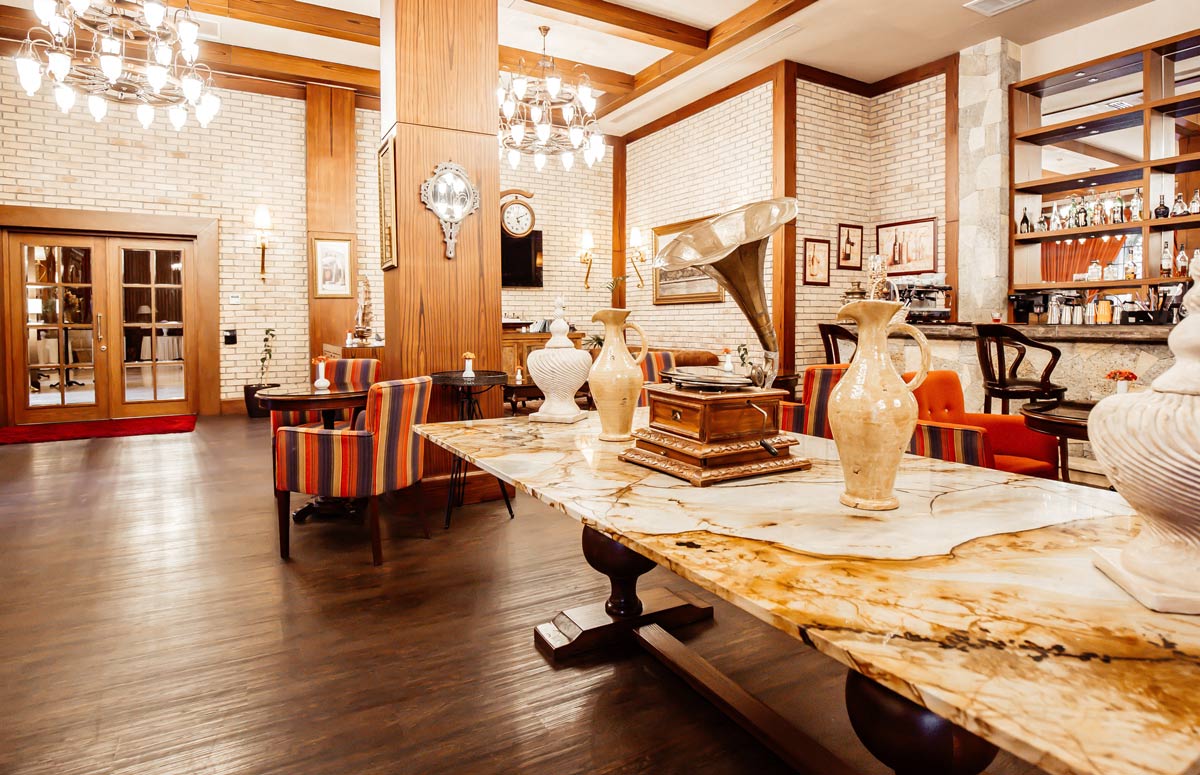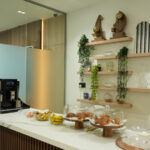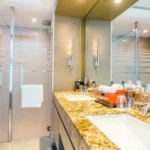- September 1, 2025
- 0 Comments
- By blueprint
Restaurant designing is not just about choosing tables and colours, it is about making an experience that is connected with people. In Japanese restaurant interior design, every element has its own meaning. The profound beauty of Japanese culture can be seen in the use of natural materials, harmonious layouts and relaxing tones, because dining is not only about the food but also about the soothing experience every customer wants. The visitors expect the feeling of calm, harmony, and genuineness as soon as they enter the restaurant.
At Blueprint Experts, we specialise in providing customised cultural interiors which satisfy the real needs of restaurants in the UAE. The recent project of a Japanese ramen restaurant interior design which our team completed demonstrates how realistic ideas can be converted into practical functional spaces. This project offered an insight into how lighting, textures, and seating layout with the touch of culture can be used together to create a comfortable and warm dining experience.
By focusing on the details, like wood finishes, soft lighting, and thoughtful seating layouts, we make sure that every restaurant space feels welcoming and true to its concept. Whether it’s a small ramen shop or a fine dining venue, our goal is to bring authentic Japanese restaurant interior design into reality, blending tradition with practical modern solutions.
Why Japanese Restaurant Interior Design Matters for Dining Experience
The interior of a restaurant plays a direct role in how people enjoy their food. With Japanese restaurant interior design, the atmosphere is just as important as the menu. A well-designed space creates comfort, sets the mood, and helps customers feel more connected to the dining experience.
In Japanese culture, design is closely linked to emotions. Clean lines, natural materials, and balanced layouts give guests a sense of peace. When these elements are present in a Japanese restaurant interior, customers are more likely to stay longer, return again, and even recommend the place to others.
At Blueprint Experts, we understand that interiors influence how people perceive the food, the service, and the overall brand. Soft lighting, carefully chosen colours, and efficient seating layouts create an environment where customers feel relaxed and engaged. For restaurants, this translates into stronger customer loyalty and a unique identity in a competitive dining market.
By treating the restaurant as more than just a dining hall, and instead as a carefully designed space, we help clients build restaurants that stand out. Our expertise in Japanese restaurant interior design allows us to balance cultural authenticity with functionality, ensuring that every detail, from the entrance to the seating, enhances the dining experience.
Core Elements of Japanese Restaurant Interior
Designing an authentic Japanese restaurant interior means paying attention to key elements that define the style. At Blueprint Experts, we bring these features together in a way that feels natural, modern, and suited to the UAE dining scene.
- Minimalism and balance: Japanese interiors are known for their clean and uncluttered look. Simplicity doesn’t mean empty; it means every element has a purpose. This principle ensures a peaceful atmosphere where the focus remains on the dining experience.
- Use of natural materials: Wood, bamboo, and stone are core materials in Japanese spaces. They bring warmth and authenticity to the design. Whether it’s wooden partitions, bamboo accents, or stone finishes, these textures make the interior feel grounded and inviting.
- Colours and textures: Soft neutrals, earthy tones, and natural finishes dominate in a Japanese interior design restaurant. These shades create calmness, while textures like linen, bamboo, and wood grain add depth without overwhelming the senses.
- Furniture and seating: The right furniture is essential. Low seating, wooden tables, and carefully designed stools reflect Japanese traditions while supporting comfort and function. Smooth edges and natural finishes ensure harmony with the overall interior.
- Subtle decoration: Instead of heavy decor, authentic design uses thoughtful accents. Lanterns, ceramics, bonsai plants, or calligraphy pieces are examples of meaningful touches. These small details also connect with popular Japanese restaurant decoration ideas, making the space memorable without being overcrowded.
By combining these elements, Blueprint Experts creates interiors that are both beautiful and practical. Every project balances tradition with usability, ensuring that restaurant owners achieve a dining environment that is authentic, efficient, and lasting.
Japanese Restaurant Design Concept – Balancing Tradition & Modernity
Every restaurant has a story, and the design concept is how that story comes to life. In the Japanese restaurant design concept, balance is everything. Traditional elements like tatami-style seating, sliding doors, or bamboo accents bring cultural authenticity, while modern touches ensure comfort, technology, and functionality.
At Blueprint Experts, we work closely with restaurant owners to define a clear Japanese restaurant interior design concept that matches the brand identity. Some projects call for a rustic, traditional feel, while others lean towards a modern Japanese restaurant interior design that blends technology with minimalism. Both approaches can create powerful results when executed with precision.
For example, a ramen bar may use warm wood, open seating, and lanterns to reflect tradition, but also include modern lighting systems and digital ordering stations for efficiency. A high-end dining restaurant may rely on clean lines, muted colours, and cultural artworks to communicate elegance while still integrating modern acoustic solutions and custom furniture for comfort.
The key is harmony. Our role at Blueprint Experts is to make sure the Japanese restaurant design concept not only looks authentic but also works smoothly in a busy dining environment. By blending tradition with modern design philosophies, we help restaurants create a unique identity that speaks to both local and international diners.
Japanese Restaurant Interior Design Concept in Action – Case Study of Ramen Restaurant
A real example shows best how ideas transform into reality. Recently, Blueprint Experts delivered a complete Japanese ramen restaurant interior design project in Dubai. This project became a model for how tradition and modernity can work together in a compact space.
Step 1: Understanding the concept
The client wanted a space that reflected the soul of a ramen shop, warm, simple, and efficient. Our team built the Japanese restaurant interior design concept around natural textures, soft lighting, and seating arrangements that felt authentic but also worked within UAE regulations.
Step 2: Layout planning
A good ramen restaurant relies on flow. We created a clear seating arrangement with counter seating for individuals, tables for small groups, and circulation paths that allowed staff to move quickly. This planning made the most of a limited space, showing how small Japanese restaurant interior design principles can be effective.
Step 3: Material selection
To achieve authenticity, we selected wood finishes, bamboo accents, and stone surfaces. These natural materials gave the space warmth and durability, ensuring it remained attractive under heavy use. Each surface is connected with traditional Japanese restaurant interior design values.
Step 4: Lighting and ambience
Lighting was layered carefully. Warm hanging lanterns created an atmosphere, while focused lights highlighted the counter and tables. This balance ensured the space felt welcoming while also being practical for dining.
Step 5: Seating arrangements
Comfort was essential. We introduced wooden stools for counter dining, compact tables for couples, and flexible seating for small groups. This variety supported different dining experiences while maintaining efficiency.
This Japanese ramen restaurant interior design project is a perfect example of how Blueprint Experts translates cultural interiors into functional, modern dining spaces. (Here, restaurant photos and visuals can be placed to showcase the layout, finishes, and lighting in detail.)
Japanese Restaurant Decoration Ideas for an Authentic Ambience
Decoration is what turns a restaurant into a memorable space. With the right choices, even simple interiors can feel authentic and inviting. At Blueprint Experts, we help clients choose meaningful Japanese restaurant decoration ideas that add personality without overwhelming the design.
- Lanterns and wall art: Hanging lanterns provide soft lighting while adding a traditional touch. Wall art featuring Japanese calligraphy or ink paintings can bring cultural depth to a Japanese restaurant interior.
- Natural elements: Small bonsai trees, ikebana (Japanese flower arrangements), or indoor plants can soften the atmosphere. These decorations reflect nature and align with the principles of harmony found in Japanese culture.
- Subtle accessories: Handmade ceramics, stone vases, or textured placemats are small details that complete the space. These are simple yet powerful ways to reinforce authenticity in a Japanese interior design restaurant.
- Lighting choices: Soft, warm lighting is a central part of Japanese restaurant decoration ideas. Paper lanterns, wooden light fixtures, or hidden lighting systems create a cosy, welcoming ambience while supporting the overall concept.
When handled carefully, these decoration ideas make a restaurant feel complete. At Blueprint Experts, we ensure that every decorative element matches the broader design, giving restaurant owners a space that is authentic, functional, and unforgettable.
Modern Japanese Restaurant Interior Design Trends
Restaurant interiors are constantly evolving, and today’s diners expect spaces that feel both authentic and modern. A modern Japanese restaurant interior design blends tradition with innovative features that suit current lifestyles and dining habits.
- Fusion of minimalism and technology: Minimalist layouts remain central to Japanese design, but they now include modern conveniences. Touch-free ordering systems, energy-efficient lighting, and acoustic treatments can be seamlessly integrated without disturbing the calm atmosphere.
- Open kitchen designs: Diners increasingly want to see the preparation of food. An open counter or visible kitchen aligns with Japanese traditions while also giving guests an engaging dining experience. In a Japanese restaurant interior, this creates transparency and trust.
- Social media-friendly aesthetics: Restaurants today also need to appeal visually. Clean lines, soft lighting, and well-placed decorative accents make the restaurant more “Instagrammable,” attracting younger audiences without losing authenticity.
At Blueprint Experts, we bring these ideas into practice by balancing modern expectations with cultural design values. Whether through lighting systems, flexible seating, or technology integration, our modern Japanese restaurant interior design solutions help restaurant owners create spaces that impress both in-person and online.
Traditional Japanese Restaurant Interior Design Inspirations
While modern trends attract attention, the roots of Japanese design lie in tradition. Authentic traditional Japanese restaurant interior design captures centuries of cultural values and aesthetics.
1. Tatami seating and sliding doors
Low tables with tatami mats or seating on cushions reflect a historic way of dining. Shoji-style sliding doors made from wood and paper add privacy while creating a soft, diffused light.
2. Bamboo and natural elements
Bamboo screens, stone pathways, and wooden partitions are timeless features. They symbolise nature and simplicity, which are central to Japanese culture.
3. Historical references
Designs inspired by tea houses, ryokan inns, or traditional wooden ramen shops bring strong cultural connections. These features can be adapted to modern spaces while maintaining their historic essence.
At Blueprint Experts, we help clients decide how much tradition to incorporate into their concept. Some projects benefit from a purely traditional approach, while others combine history with modern comfort. By carefully integrating a Japanese restaurant design concept rooted in culture, restaurants can stand out in today’s market while still feeling timeless.
Japanese Kitchen Interior & Decor Ideas
The kitchen is the heart of any restaurant. In Japanese dining, it is often visible to guests, so the design must balance efficiency and style. At Blueprint Experts, we pay special attention to both layout and finishing to deliver functional yet elegant spaces.
Japanese Kitchen Interior Design Principles
When planning a Japanese kitchen interior design, the layout should prioritise flow and efficiency. Counters are often open, allowing guests to watch chefs at work. Materials such as natural wood and stone keep the design authentic, while stainless steel elements provide hygiene and durability.
A Japanese kitchen interior should also remain uncluttered. Smart storage solutions, hidden shelving, and compact preparation zones allow the space to stay organised while supporting fast-paced operations. The overall look must feel connected to the restaurant dining area, creating a seamless experience for guests.
Japanese Kitchen Decor Ideas
Decoration in kitchens is subtle but meaningful. For example, ceramic bowls, earthenware jars, or traditional utensils can double as display pieces. These add authenticity while remaining practical.
Lighting is also a vital part of Japanese kitchen decor ideas. Warm task lighting ensures chefs can work efficiently, while soft ambient lights make the kitchen inviting when visible to guests. Small touches, like bamboo trays, stone counters, or wooden shelving, create a connection with tradition.
By combining these principles, Blueprint Experts designs kitchens that are not only efficient for staff but also visually connected to the restaurant’s theme. Whether the space calls for a modern counter or a traditional open kitchen, our expertise in Japanese kitchen interior design and Japanese kitchen decor ideas ensures a result that works both practically and aesthetically.
Small Japanese Restaurant Interior Design – Space Optimization
Designing a small Japanese restaurant interior design requires smart strategies to use space efficiently while keeping the ambience authentic and welcoming. At Blueprint Experts, we focus on solutions that balance style, comfort, and functionality.
Key Space Optimization Strategies:
- Smart Seating Layouts: Compact table arrangements, built-in benches, and foldable furniture maximise space without making guests feel crowded.
- Hidden Storage Solutions: Clever storage units and multifunctional furniture keep the Japanese restaurant interior organised and clutter-free.
- Lighting for Ambience & Space: Warm, diffused lighting enhances intimacy, while reflective surfaces and light tones create the impression of a larger dining area.
- Effective Zoning: Clearly defined dining, kitchen, and service zones improve circulation and efficiency, even in smaller layouts.
- Open Layouts with Subtle Dividers: Creates the illusion of space while preserving privacy and functionality.
- Authenticity with Efficiency: Every design element maintains the cultural feel of a Japanese restaurant interior while ensuring commercial viability.
At Blueprint Experts, we bring years of expertise in small Japanese restaurant interior design. From ramen shops to sushi counters, our designs ensure every square metre delivers value, comfort, and an authentic guest experience.
How Blueprint Experts Deliver Unique Japanese Interior Design Restaurant Projects
At Blueprint Experts, we pride ourselves on delivering one-of-a-kind Japanese interior design restaurant projects tailored to each client’s brand and audience. Our design philosophy respects traditional Japanese elements, such as natural wood finishes, paper lantern lighting, and minimalist layouts, while adapting them to modern hospitality needs.
A standout example of our work is a Japanese ramen restaurant interior design project we completed in Dubai. The client wanted a cosy yet modern space that captured the essence of Japan while appealing to the city’s multicultural diners. We incorporated custom wood panelling, ambient lighting inspired by Japanese lanterns, and compact counter seating to replicate the feel of an authentic ramen bar. The result was a space that not only impressed customers but also optimised service efficiency for staff.
Our process begins with understanding the client’s vision, conducting market research, and creating design concepts that balance cultural authenticity with commercial practicality. Every Japanese restaurant interior design project is approached with attention to detail, from material selection to layout planning and lighting design.
If you’re considering launching or renovating a Japanese restaurant, Blueprint Experts can help bring your vision to life. We deliver interiors that blend culture, creativity, and business strategy, ensuring your restaurant stands out in Dubai’s competitive dining scene.
Conclusion – Crafting the Perfect Japanese Restaurant Interior Design
The success of a restaurant lies in more than just its menu; its interiors define the dining experience. From space optimisation strategies to authentic decoration ideas and efficient kitchen layouts, every detail matters in Japanese restaurant interior design.
At Blueprint Experts, we create interiors that respect tradition while embracing innovation. Whether you are inspired by a modern ramen shop or drawn to a timeless Japanese restaurant design concept, our team ensures your space reflects both culture and functionality.
With expertise in cultural design and experience in Dubai’s restaurant market, we’re here to help you craft interiors that elevate your brand.
Explore our project gallery or connect with us today to begin building your ideal customized restaurant.
Call us today
Request a free consultation
Interiors into spaces that inspire and function beautifully.










